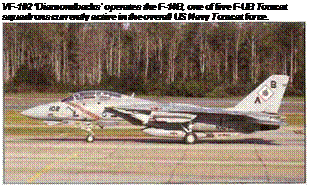Northrop Grumman F-14 Tomcat Naval strike fighter
|
|
D |
esigned as a successor to the F-4 in the fleet air defence role, the Grumman F-14A Tomcat was conceived to engage and destroy targets at extreme range using the AWG-9 fire control system and AIM-54 Phoenix missiles. It remains the US Navy’s standard carrier-based interceptor. The first development aircraft flew on 21 December 1970. Deliveries to the Navy began in October 1972. with the first operational cruise in 1974.
Problems with the F-14A’s TF-30 turbofan were a key factor in the development of re-engined and upgraded Tomcat variants. One airframe was fitted with F4Q1-PW-4Q0S and tested as the F-14B as early as 1973-74. This aircraft later re-emerged as the F-14B Super Tomcat with F101DFE engines. This engine was developed into the GE F100-GE – 400 turbofan, which was selected to power improved Tomcat variants. Two re-engined variants were proposed: the F-14A-1- was to be an interim type, while the F-14D would introduce improved digital avionics Subsequently, the F-l4A(Plus) was redesignated as the F-14B, 38 new-build examples being joined by 32 F-14A rebuilds by 1988. These incorporated some avionics changes, including a modernised fire control system, new radios, upgraded RWRs, and various cockpit changes.
The first new-build F-14D made its first flight on 9 February 1990. The F-14D added digital radar processing and displays to the AWG-9, resulting in a designation change to APG-71. and a dual undernose TCS/IRST sensor pod. Other improvements include NACES ejection seats, and AN/ALR-67 RWR equipment Defence cuts resulted in the service receiving only 37 new-build aircraft, with deliveries beginning in 1990. Deliveries of rebuilt F-14D rebuilds finished at 110, in 1995. A proposed Tomcat 21 strike fighter lost out against the F/A – 18E/F Super Hornet.
In late 1990 the air-ground potential of the F-14 began to be exploited as the Bombcat’ entered the fleet, albeit with ‘dumb’ bombs only. LGBs were cleared for use in 1994 and in September 1995 VF-41 dropped them in action against Bosnian Serb forces. LANTIRN has been integrated with the F-14 allowing self-designation for LGBs, and has seen action over Yugoslavia and Iraq, Other new Bombcat weapons include JDAM and JSOW.
From 2002, the F-14 will be progressively replaced by the F/A-18F Super Hornet, and will be completely phased out by 2010, Until then, the F-14 continues to be upgraded, most recently with a Digital Flight Control System (DFCS).
 Specification: Northrop Grumman F-140 Powerpjant: two 102.75-kN (23,100-lb) General Electric F110-GE-400 Turbofans Dimensions: wing span 19.54 m (64 ft VA in) spread, 11.65 m (38 ft 2У in| swept and 10.15 m (33 ft ЗУ, in) overswept; length 19.10 m (62 ft 8 in); height 4.88 m (16 ft)
Specification: Northrop Grumman F-140 Powerpjant: two 102.75-kN (23,100-lb) General Electric F110-GE-400 Turbofans Dimensions: wing span 19.54 m (64 ft VA in) spread, 11.65 m (38 ft 2У in| swept and 10.15 m (33 ft ЗУ, in) overswept; length 19.10 m (62 ft 8 in); height 4.88 m (16 ft)
Weights: empty 18951 kg (41,780 lb); maximum take-off 33724 kg [74,349 lb) Performance: maximum level speed 1997 kmh (1,241 mph): max rate of climb at sea level more than 9145 m [30,000 ft) per minute; service ceiling more than 16150 m (53.000 ft); combat radius on a CAP 1994 km [1,239 miles) Armament: one M61 Vulcan 20-mm cannon; maximum ordnance 6577 kg (14,500 lb)












